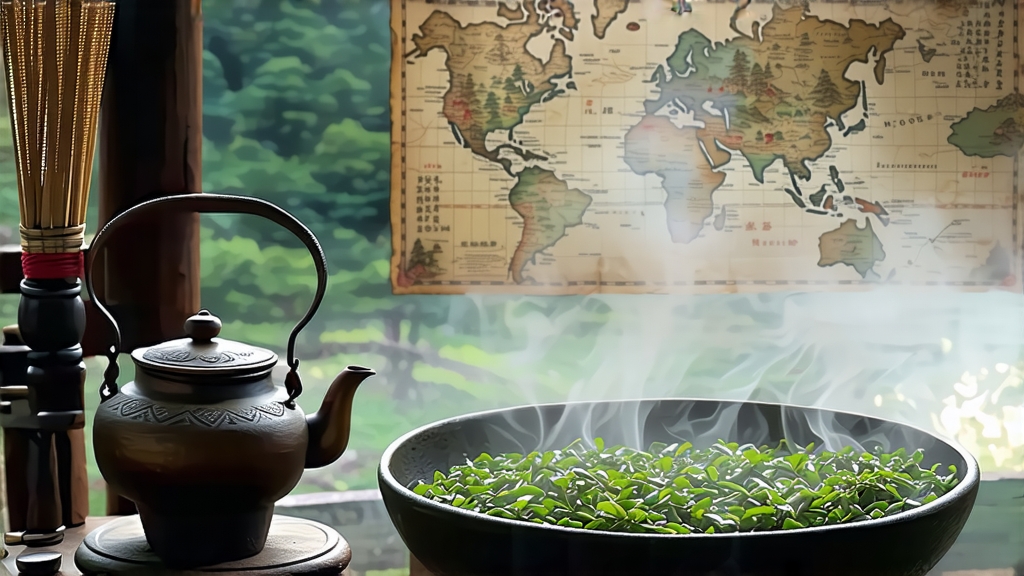
Ask most tea lovers to name the first black tea ever created and they will probably pause; mention Lapsang Souchong, however, and eyes light up with images of crackling pine fires and deep, smoky liquor. Hailing from the granite gorges of the Wuyi Mountains in China’s north-western Fujian province, this remarkable tea is not only the progenitor of every black tea on earth but also a living testament to the ingenuity of 17th-century tea masters who turned misfortune into aroma. Today we journey through its storied past, its two distinct styles, the meticulous craft that imbues it with campfire soul, and the gongfu rituals that coax out layers far more nuanced than “smoke in a cup”.
History: From Misty Gorges to European Courts
Local legend places Lapsang’s birth during the late Ming dynasty, when Qing troops allegedly billeted in Tongmu village interrupted the spring tea harvest. Eager to dry the leaves quickly and reach market, farmers spread them over fresh pinewood fires; the resulting tea, copper-red and laced with resinous fragrance, found unexpected favour with Dutch traders at Xiamen port. By 1604 the first chests reached Amsterdam, and within decades “bohea” (the Fujianese pronunciation of “Wuyi”) became Europe’s generic term for black tea. British merchants later carried it to London coffee-houses where it was sweetened, milked, and eventually imitated in India and Ceylon. Thus every modern black tea traces its lineage to that accidental encounter between tea leaf and pine smoke in Tongmu.
Terroir: Why Only Tongmu Tastes Like Tongmu
The Wuyi range is a UNESCO World Heritage site whose narrow gorges trap morning mists, creating a humid micro-climate that slows leaf growth and concentrates amino acids. Soils are mineral-rich, weathered granite mixed with volcanic tuff; the same bedrock that gifts rock oolong their “yan yun” (rock rhyme) lends Souchong a subtle stony coolness beneath the smoke. Strict geographic indication rules limit authentic Lapsang to 670 hectares within Tongmu Guan and three neighbouring hamlets; step outside this radius and the law forbids use of the name.
Cultivars: Two Families, One Leaf
Most gardens are planted with Xiao Ye Zhong (“small-leaf species”), a hardy Wuyi ecotype that withstands cool nights and produces malty sweetness. Since 2005 an offshoot known as Jin Jun Mei—literally “golden beautiful eyebrow”—has risen to fame. Made solely from tiny spring buds and processed without smoke, it is technically still a Souchong because it originates in Tongmu, but its honeyed, dried-longan profile sits at the opposite pole to the classic pine-smoke style. Understanding this split is essential: when Westerners say “Lapsang” they usually mean the smoked version, while Chinese retailers may offer both.
Craft: Turning Green Leaf into Smoky Velvet
Harvest begins in mid-April, when three leaves and a bud are plucked at 7–9 cm length. The leaves are withered in wooden lofts above pine-fired hearths; smoke wafts upward through bamboo slats, desiccating the leaf while impregnating it with volatile guaiacol and syringol compounds. After 8–10 hours the leaf is pliable enough to roll, a gentle twisting that breaks cell walls and initiates oxidation. Rolling is still done by hand in Tongmu; the operator’s palms judge pressure the way a baker tests dough. Oxidation follows in rattan baskets lined with wet cloth; temperature is maintained around 24 °C for 3–4 hours until the leaf turns a uniform mahogany. The critical smoking stage now begins: fresh pinewood is sawn into 40 cm logs, lit, and smothered to create a cool smoulder (28–32 °C). Layers of tea rest on bamboo trays above the smoke for six to eight hours, absorbing aroma without scorching. Finally the leaf is baked over charcoal embers to fix the flavour, then rested for at least a month so smoke integrates with the tea’s own sweetness.
Grades: Smoke, Leaf, and Balance
Top-grade Tongmu Lapsang exhibits long, glossy strips with golden tips and an aroma that marries pine resin, dried longan, and a whisper